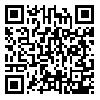Volume 79, Issue 7 (October 2021)
Tehran Univ Med J 2021, 79(7): 533-545 |
Back to browse issues page
Download citation:
BibTeX | RIS | EndNote | Medlars | ProCite | Reference Manager | RefWorks
Send citation to:



BibTeX | RIS | EndNote | Medlars | ProCite | Reference Manager | RefWorks
Send citation to:
Abbasabadi-Arab M, Mosadeghrad A M, Khankeh H R, Biglarian A. Development of hospital disaster risk management accreditation standards. Tehran Univ Med J 2021; 79 (7) :533-545
URL: http://tumj.tums.ac.ir/article-1-11363-en.html
URL: http://tumj.tums.ac.ir/article-1-11363-en.html
1- National Medical Emergency Organization, Ministry of Health and Medical Education, Tehran, Iran.
2- Department of Health Management and Economics, Health Information Management Research Center, School of Public Health, Tehran University of Medical Sciences, Tehran, Iran.
3- Health in Emergency and Disaster Research Center, University of Social Welfare and Rehabilitation Sciences, Tehran, Iran.
4- Department of Biostatistics, University of Social Welfare and Rehabilitation Sciences, Tehran, Iran.
2- Department of Health Management and Economics, Health Information Management Research Center, School of Public Health, Tehran University of Medical Sciences, Tehran, Iran.
3- Health in Emergency and Disaster Research Center, University of Social Welfare and Rehabilitation Sciences, Tehran, Iran.
4- Department of Biostatistics, University of Social Welfare and Rehabilitation Sciences, Tehran, Iran.
Abstract: (2208 Views)
Background: The preparedness and safety of hospitals in disasters are essential to maintain the health and survival of the community. Numerous studies have shown that the level of preparedness of Iranian hospitals is moderate and low. Lack of comprehensive hospital standards for disaster preparedness is one of the reasons. This study aimed to develop hospital accreditation standards for hospital disaster risk management.
Methods: This comparative study was conducted between April and September 2016. Hospital disaster risk management accreditation standards were extracted from the hospital accreditation standards of 11 countries including the United States, Canada, Australia, Malaysia, India, Thailand, Egypt, Turkey, Saudi Arabia, Denmark and Iran. Overall, 27 hospital disaster risk management accreditation standards were introduced. The opinions of 22 disaster risk management experts were used to assess the content validity of the proposed disaster risk management accreditation standards.
Results: Differences were observed in the quality and quantity of those countries’ disaster risk management standards. The national accreditation standards of the United States, Australia, and Canada had comprehensive standards and covered all aspects of the disaster risk management cycle. Finally, 27 standards were proposed for developing Iranian hospitals’ disaster risk management accreditation standards. The CVI & CVR validity of the proposed standards were acceptable.
There were significant differences in the quantity and quality of hospital disaster risk management accreditation standards in selected countries. The most comprehensive standards belonged to the US National Standards (12 standards and 113 sub-standards), followed by the Australian and Canadian accreditation standards. The accreditation standards of the developing countries and Iran were not comprehensive and did not meet the international goals of disaster risk management. The proposed hospital disaster risk management accreditation standards had high content validity.
Conclusion: Disaster risk management accreditation standards in Iran and developing countries need to be revised and upgraded. Comprehensive standards based on international experiences and expert opinions were introduced in this study that can be used to develop hospital accreditation standards in Iran and other countries.
Methods: This comparative study was conducted between April and September 2016. Hospital disaster risk management accreditation standards were extracted from the hospital accreditation standards of 11 countries including the United States, Canada, Australia, Malaysia, India, Thailand, Egypt, Turkey, Saudi Arabia, Denmark and Iran. Overall, 27 hospital disaster risk management accreditation standards were introduced. The opinions of 22 disaster risk management experts were used to assess the content validity of the proposed disaster risk management accreditation standards.
Results: Differences were observed in the quality and quantity of those countries’ disaster risk management standards. The national accreditation standards of the United States, Australia, and Canada had comprehensive standards and covered all aspects of the disaster risk management cycle. Finally, 27 standards were proposed for developing Iranian hospitals’ disaster risk management accreditation standards. The CVI & CVR validity of the proposed standards were acceptable.
There were significant differences in the quantity and quality of hospital disaster risk management accreditation standards in selected countries. The most comprehensive standards belonged to the US National Standards (12 standards and 113 sub-standards), followed by the Australian and Canadian accreditation standards. The accreditation standards of the developing countries and Iran were not comprehensive and did not meet the international goals of disaster risk management. The proposed hospital disaster risk management accreditation standards had high content validity.
Conclusion: Disaster risk management accreditation standards in Iran and developing countries need to be revised and upgraded. Comprehensive standards based on international experiences and expert opinions were introduced in this study that can be used to develop hospital accreditation standards in Iran and other countries.
Type of Study: Original Article |
| Rights and permissions | |
 |
This work is licensed under a Creative Commons Attribution-NonCommercial 4.0 International License. |





